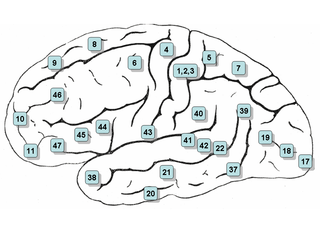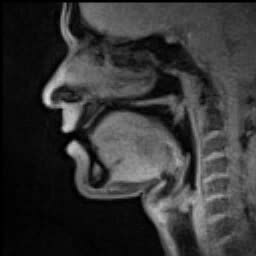Related Research Articles

In neuroscience and psychology, the term language center refers collectively to the areas of the brain which serve a particular function for speech processing and production. Language is a core system that gives humans the capacity to solve difficult problems and provides them with a unique type of social interaction. Language allows individuals to attribute symbols to specific concepts, and utilize them through sentences and phrases that follow proper grammatical rules. Finally, speech is the mechanism by which language is orally expressed.

Broca's area, or the Broca area, is a region in the frontal lobe of the dominant hemisphere, usually the left, of the brain with functions linked to speech production.
Syntactic ambiguity, also known as structural ambiguity, amphiboly, or amphibology, is characterized by the potential for a sentence to yield multiple interpretations due to its ambiguous syntax. This form of ambiguity is not derived from the varied meanings of individual words but rather from the relationships among words and clauses within a sentence, concealing interpretations beneath the word order. Consequently, a sentence presents as syntactically ambiguous when it permits reasonable derivation of several possible grammatical structures by an observer.
Psycholinguistics or psychology of language is the study of the interrelation between linguistic factors and psychological aspects. The discipline is mainly concerned with the mechanisms by which language is processed and represented in the mind and brain; that is, the psychological and neurobiological factors that enable humans to acquire, use, comprehend, and produce language.

Neurolinguistics is the study of neural mechanisms in the human brain that control the comprehension, production, and acquisition of language. As an interdisciplinary field, neurolinguistics draws methods and theories from fields such as neuroscience, linguistics, cognitive science, communication disorders and neuropsychology. Researchers are drawn to the field from a variety of backgrounds, bringing along a variety of experimental techniques as well as widely varying theoretical perspectives. Much work in neurolinguistics is informed by models in psycholinguistics and theoretical linguistics, and is focused on investigating how the brain can implement the processes that theoretical and psycholinguistics propose are necessary in producing and comprehending language. Neurolinguists study the physiological mechanisms by which the brain processes information related to language, and evaluate linguistic and psycholinguistic theories, using aphasiology, brain imaging, electrophysiology, and computer modeling.

In psycholinguistics, language processing refers to the way humans use words to communicate ideas and feelings, and how such communications are processed and understood. Language processing is considered to be a uniquely human ability that is not produced with the same grammatical understanding or systematicity in even human's closest primate relatives.
The language module or language faculty is a hypothetical structure in the human brain which is thought to contain innate capacities for language, originally posited by Noam Chomsky. There is ongoing research into brain modularity in the fields of cognitive science and neuroscience, although the current idea is much weaker than what was proposed by Chomsky and Jerry Fodor in the 1980s. In today's terminology, 'modularity' refers to specialisation: language processing is specialised in the brain to the extent that it occurs partially in different areas than other types of information processing such as visual input. The current view is, then, that language is neither compartmentalised nor based on general principles of processing. It is modular to the extent that it constitutes a specific cognitive skill or area in cognition.
The cognitive revolution was an intellectual movement that began in the 1950s as an interdisciplinary study of the mind and its processes, from which emerged a new field known as cognitive science. The preexisting relevant fields were psychology, linguistics, computer science, anthropology, neuroscience, and philosophy. The approaches used were developed within the then-nascent fields of artificial intelligence, computer science, and neuroscience. In the 1960s, the Harvard Center for Cognitive Studies and the Center for Human Information Processing at the University of California, San Diego were influential in developing the academic study of cognitive science. By the early 1970s, the cognitive movement had surpassed behaviorism as a psychological paradigm. Furthermore, by the early 1980s the cognitive approach had become the dominant line of research inquiry across most branches in the field of psychology.

Speech is a human vocal communication using language. Each language uses phonetic combinations of vowel and consonant sounds that form the sound of its words, and using those words in their semantic character as words in the lexicon of a language according to the syntactic constraints that govern lexical words' function in a sentence. In speaking, speakers perform many different intentional speech acts, e.g., informing, declaring, asking, persuading, directing, and can use enunciation, intonation, degrees of loudness, tempo, and other non-representational or paralinguistic aspects of vocalization to convey meaning. In their speech, speakers also unintentionally communicate many aspects of their social position such as sex, age, place of origin, physical states, psychological states, physico-psychological states, education or experience, and the like.
Donald P. ShankweilerArchived 2006-06-26 at the Wayback Machine is an eminent psychologist and cognitive scientist who has done pioneering work on the representation and processing of language in the brain. He is a Professor Emeritus of Psychology at the University of Connecticut, a Senior Scientist at Haskins Laboratories in New Haven, Connecticut, and a member of the Board of Directors Archived 2021-01-26 at the Wayback Machine at Haskins. He is married to well-known American philosopher of biology, psychology, and language Ruth Millikan.
Sentence processing takes place whenever a reader or listener processes a language utterance, either in isolation or in the context of a conversation or a text. Many studies of the human language comprehension process have focused on reading of single utterances (sentences) without context. Extensive research has shown that language comprehension is affected by context preceding a given utterance as well as many other factors.
The early left anterior negativity is an event-related potential in electroencephalography (EEG), or component of brain activity that occurs in response to a certain kind of stimulus. It is characterized by a negative-going wave that peaks around 200 milliseconds or less after the onset of a stimulus, and most often occurs in response to linguistic stimuli that violate word-category or phrase structure rules. As such, it is frequently a topic of study in neurolinguistics experiments, specifically in areas such as sentence processing. While it is frequently used in language research, there is no evidence yet that it is necessarily a language-specific phenomenon.
The Competition Model is a psycholinguistic theory of language acquisition and sentence processing, developed by Elizabeth Bates and Brian MacWhinney (1982). The claim in MacWhinney, Bates, and Kliegl (1984) is that "the forms of natural languages are created, governed, constrained, acquired, and used in the service of communicative functions." Furthermore, the model holds that processing is based on an online competition between these communicative functions or motives. The model focuses on competition during sentence processing, crosslinguistic competition in bilingualism, and the role of competition in language acquisition. It is an emergentist theory of language acquisition and processing, serving as an alternative to strict innatist and empiricist theories. According to the Competition Model, patterns in language arise from Darwinian competition and selection on a variety of time/process scales including phylogenetic, ontogenetic, social diffusion, and synchronic scales.
The Modular Online Growth and Use of Language (MOGUL) project is the cover term name for any research on language carried out using the Modular Cognition Framework (MCF).
Cognitive musicology is a branch of cognitive science concerned with computationally modeling musical knowledge with the goal of understanding both music and cognition.
In psychology, a lemma is an abstract conceptual form of a word that has been mentally selected prior to the early stages of speech production. This concept is used to explain how the process of generating speech occurs. In particular, lemmas are seen as the mental representations of words that are organised and retrieved from memory before they are eventually spoken.. A lemma represents a specific meaning but does not have any specific sounds that are attached to it.
The auditory moving-window is a psycholinguistic paradigm developed at Michigan State University by Fernanda Ferreira and colleagues. Ferreira and colleagues built the paradigm in order to address the scarcity of (fluent) spoken-language comprehension literature versus the robustness of that for visual-word processing. Auditory moving-window can be used to assess indirectly the processing load of a sentence: this processing load is assessed by an analogue of reaction time within the paradigm. Reaction times within the paradigm are sensitive to at least word frequency and garden path effects.
Raymond W. Gibbs Jr. is a former psychology professor and researcher at the University of California, Santa Cruz. His research interests are in the fields of experimental psycholinguistics and cognitive science. His work concerns a range of theoretical issues, ranging from questions about the role of embodied experience in thought and language, to looking at people's use and understanding of figurative language. Raymond Gibbs's research is especially focused on bodily experience and linguistic meaning. Much of his research is motivated by theories of meaning in philosophy, linguistics, and comparative literature.
Randi Martin is the Elma Schneider Professor of Psychology at Rice University and Director of the T. L. L. Temple Foundation Neuroplasticity Research Laboratory. With Suparna Rajaram and Judith Kroll, Martin co-founded Women in Cognitive Science in 2001, an organization supported in part through the National Science Foundation's ADVANCE Leadership program. She is a Fellow of the American Association for the Advancement of Science (AAAS) and the Society of Experimental Psychologists (SEP).
Seana Coulson is a cognitive scientist known for her research on the neurobiology of language and studies of how meaning is constructed in human language, including experimental pragmatics, concepts, semantics, and metaphors. She is a professor in the Cognitive Science department at University of California, San Diego, where her Brain and Cognition Laboratory focuses on the cognitive neuroscience of language and reasoning.
References
- 1 2 3 4 5 "APA Distinguished Scientific Awards for an Early Career Contribution to Psychology". www.apa.org. Retrieved 2021-03-16.
- ↑ "People - Ferreira Lab: University of California, Davis".
- 1 2 3 4 5 "Fernanda Ferreira — People in the Social Science Departments at UC Davis". psychology.ucdavis.edu. Retrieved 2021-03-02.
- ↑ "Association for Psychological Science: APS Fellows". www.psychologicalscience.org. Archived from the original on 2018-05-20. Retrieved 2021-03-16.
- ↑ "Fellows of the Society". Cognitive Science Society. Archived from the original on 2022-04-04. Retrieved 2021-03-16.
- ↑ "Professor Maria Fernanda Ferreira FRSE". The Royal Society of Edinburgh. 2020-08-24. Retrieved 2021-04-21.
- ↑ "Neurotree Webpage".
- ↑ Ferreira, Maria Fernanda (1988). Planning and timing in sentence production: The syntax-to-phonology conversion (Thesis). ProQuest 303594196.
- 1 2 3 "Collabra: Psychology Editor Spotlight". 13 September 2017.
- ↑ Cognitive Psychology Editorial Board.
- ↑ "Psychology Department, UC Davis: John M Henderson".
- ↑ "Department of Psychology, UC San Diego: Victor Ferreira".
- ↑ Ferreira, F (September 2003). "The misinterpretation of noncanonical sentences". Cognitive Psychology. 47 (2): 164–203. doi:10.1016/S0010-0285(03)00005-7. PMID 12948517. S2CID 3863800.
- ↑ Ferreira, Fernanda; Bailey, Karl G.D.; Ferraro, Vittoria (February 2002). "Good-Enough Representations in Language Comprehension". Current Directions in Psychological Science. 11 (1): 11–15. doi:10.1111/1467-8721.00158. S2CID 4126375.
- ↑ Engelhardt, Paul E.; Ferreira, Fernanda; Jones, Manon W. (2009). "Good Enough Language Processing: A Satisficing Approach". Proceedings of the Annual Meeting of the Cognitive Science Society. 31 (31).
- ↑ Ferreira, Fernanda; Anes, Michael D.; Horine, Matthew D. (March 1996). "Exploring the use of prosody during language comprehension using the auditory moving window technique". Journal of Psycholinguistic Research. 25 (2): 273–290. doi:10.1007/BF01708574. PMID 8667299. S2CID 31551267.
- ↑ Ferreira, Fernanda; Henderson, John M.; Anes, Michael D.; Weeks, Phillip A.; McFarlane, David K. (March 1996). "Effects of lexical frequency and syntactic complexity in spoken-language comprehension: Evidence from the auditory moving-window technique". Journal of Experimental Psychology: Learning, Memory, and Cognition. 22 (2): 324–335. doi:10.1037/0278-7393.22.2.324.